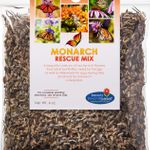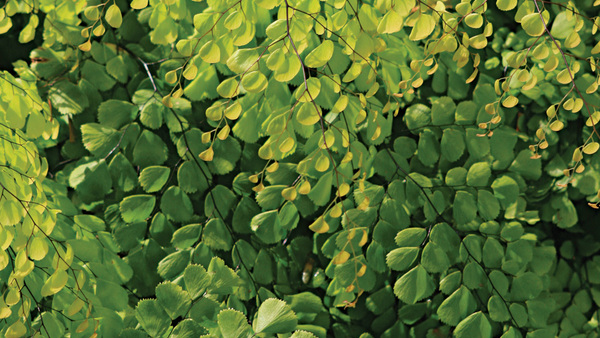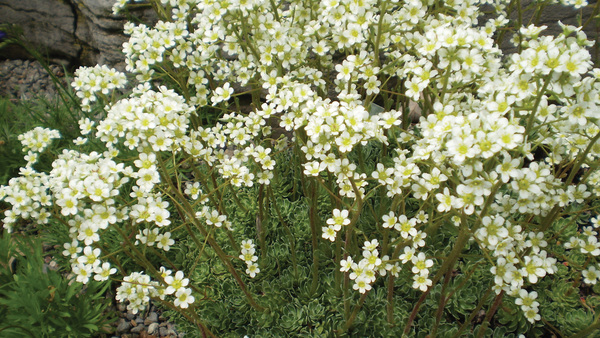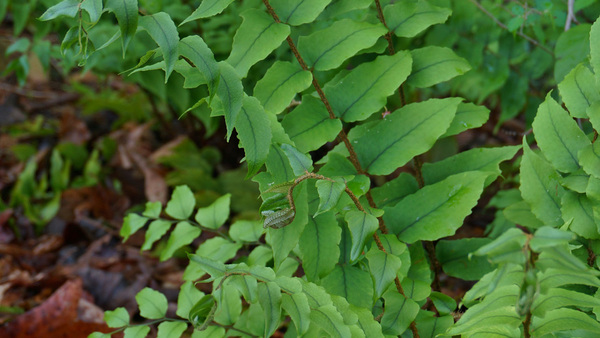
‘Twisted Tongue’ agave
Agave × amourifolia ‘Twisted Tongue’
Zones: 7–10
Size: 3 feet tall and 4 to 5 feet wide
Conditions: Full sun; well-drained soil
Native range: Hybrid of Southwestern United States and Mexico native species
This agave is a hybrid introduced in 2018 that promises to be a stellar statement plant either in the ground or as a “thriller” in large containers. ‘Twisted Tongue’ features broad greenish-blue foliage that is serrated with dark red to black leaf edges and spring-blooming yellow flower spikes. This perennial would look great growing among native sedge species (Carex spp. and cvs., Zones 3–10) or used as a focal point in a rock garden. ‘Twisted Tongue’ is also a good choice for a pollinator garden, as hummingbirds love its flowers. While this drought-tolerant plant is deer and rabbit resistant, it’s a favorite of slugs. It takes some years to mature but will easily survive in areas where winters see frosty and/or snowy conditions.
Dragonfly™ bergenia
Bergenia ‘Angel Kiss’
Zones: 4–9
Size: 8 to 18 inches tall and 6 to 12 inches wide
Conditions: Full sun to full shade; moist, well-drained soil
Native range: Hybrid
Dragonfly™ bergenia is a winter-hardy dwarf variety that flourishes in a wide zonal range. To ensure beautiful foliage and blooms, plant in dappled sun conditions, although it will be fine in deep shade. In late spring expect a profusion of white to light pink flowers. The green foliage also turns a rich wine color in fall. This is a reliable plant that will give your garden a sophisticated look, and it will naturalize as a ground cover in optimum growing conditions. Dragonfly™ bergenia is also deer and rabbit resistant. While it’s hardy to Zone 4, be sure to mulch around your plant to protect it from hard frosts if you aren’t expecting much insulating snow.
‘Little Hulk’ evergreen Solomon’s seal
Disporopsis pernyi ‘Little Hulk’
Zones: 6–9
Size: 12 to 24 inches tall and 8 to 12 inches wide
Conditions: Partial to full shade; moist, well-drained soil
Native range: Southern China
One of my favorite low-maintenance ground covers, ‘Little Hulk’ evergreen Solomon’s seal creates a deep green, almost tropical-looking effect with its arched, waxy foliage and pendulous creamy white flowers that bloom in spring. Later in fall, purple-blue berries replace the flowers. ‘Little Hulk’ spreads via rhizomes, and the key to containing its vigorous growth is to site it in deep shade. The more dappled the light, the faster it will colonize an area. Because of its height and erect habit, planting it in the back of a bed is best, where it can hover over smaller perennials. While deer don’t tend to go for this plant, watch out for slugs, especially in spring.
Singlehead pussytoes
Antennaria solitaria
Zones: 5–8
Size: 4 to 6 inches tall and wide
Conditions: Full sun to partial shade; medium to dry, well-drained soil
Native range: East-central and southeastern United States
Not often seen in gardens, singlehead pussytoes is an attractive native ground cover commonly found in eastern forests that grows in acidic soil with heavy leaf matter. This perennial is ideal for partial-shade gardens and grows well among smaller hostas (Hosta spp. and cvs., Zones 3–8) and shade-loving ferns. Its late, spring-blooming white flowers, which can reach up to a foot tall, dazzle the eye. This plant needs well-drained soil and can be finicky to establish if its soil and light conditions aren’t met. It often does well in poor soil that contains sand, rocky material, or clay, and it requires very little irrigation. Singlehead pussytoes spreads through stolons, and the dark greenish-purple basal leaves will form a nice mat over time.
Wambui Ippolito is a landscape designer and horticulturist based in New York City.
Fine Gardening Recommended Products

Monarch Butterfly Rescue Wildflower Seeds 4 oz.
Fine Gardening receives a commission for items purchased through links on this site, including Amazon Associates and other affiliate advertising programs.

A.M. Leonard Deluxe Soil Knife & Leather Sheath Combo
Fine Gardening receives a commission for items purchased through links on this site, including Amazon Associates and other affiliate advertising programs.

Plant Covers Freeze Protection 10 ft x 30 ft Floating Row Cover 0.9oz/yd²
Fine Gardening receives a commission for items purchased through links on this site, including Amazon Associates and other affiliate advertising programs.























Comments
Log in or create an account to post a comment.
Sign up Log in